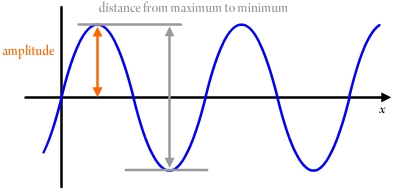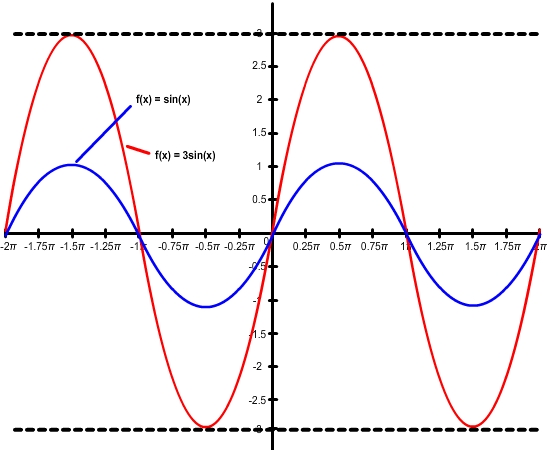Amplitude
The first topic that needs to be discussed is the amplitude of a function. The amplitude is the value of half the distance between the minimum and maximum values of the range of a periodic function.
For f(x) = Asin(x) and f(x) = Acos(x), the amplitude is defined as the absolute value of A, written as |A|. Remember that absolute value is a measure of distance; therefore, it can never be negative. For example: |3| = 3 and |-3| = 3.
Another way to state the definition of amplitude is to write the equation:
![A equals the absolute value of the quantity [A - (-A)]/2](../images/MTH08-68.19098.gif)
The following diagram illustrates the amplitude of a trigonometric function:

The following is an example that shows what happens to the graph of a trigonometric function when you change the amplitude.
For f(x) = 3sin(x), A = 3, therefore, the amplitude is |3| = 3.
You need to look at the graphs of f(x) = 3sin(x) and f(x) = sin(x) to see how they compare and note how the value of A changes the graph of f(x) = sin(x).
You start by building a table of the values:
| x |
|
| - |
| 0 |
|
|
|
|
| sin(x) | 0 | 1 | 0 | -1 | 0 | 1 | 0 | -1 | 0 |
| 3sin(x) | 0 | 3 | 0 | -3 | 0 | 3 | 0 | -3 | 0 |
Now graph the two functions together so you can compare them:

The dotted lines represent the maximum and minimum values of f(x) = 3sin(x). The maximum value is 3 and the minimum value is -3. Given the equation for amplitude:
![A = absolute value of the quantity [A - (-A)]/2; A = absolute value of the quantity [3 - (-3)]/2; so A = |3| = 3](../images/MTH08-68.19113.gif)
You can now see how the amplitude equation works. You should also notice that this amplitude value makes the graph three times taller than our original function f(x) = sin(x).
Please note: The tangent function has no amplitude because it has no minimum or maximum values.






